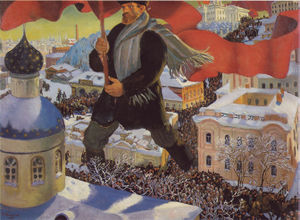Menshevik
- This article is about the Mensheviks as a faction inside the Russian Social Democratic Labour Party. For the history of the Menshevik movement as an independent political party after 1912, see Russian Social Democratic Labour Party (Mensheviks).
The Mensheviks (Russian: Меньшевик, Russian pronunciation: [mʲɪnʲʂɨˈvʲik]) were a faction of the Russian revolutionary movement that emerged in 1904 after a dispute between Vladimir Lenin and Julius Martov, both members of the Russian Social-Democratic Labour Party. The dispute originated at the Second Congress of that party, ostensibly over minor issues of party organization. Martov's supporters, who were in the minority in a crucial vote on the question of party membership, came to be called "Mensheviks", derived from the Russian word меньшинство (men'shinstvo, "minority"), whereas Lenin's adherents were known as "Bolsheviks", from bol'shinstvo ("majority").
Neither side held a consistent majority over the course of the congress. The split proved to be long-standing and had to do both with pragmatic issues based in history such as the failed revolution of 1905, and theoretical issues of class leadership, class alliances, and bourgeois democracy. While both factions believed that a "bourgeois democratic" revolution was necessary, the Mensheviks generally tended to be more moderate and were more positive towards the "mainstream" liberal opposition.
Contents |
The split
At the 2nd Congress of the RSDLP in August 1903, Lenin and Martov disagreed, first about which persons should be in the editorial committee of the party newspaper Iskra, and then about the definition of a "party member" in the future party statute. While the difference in the definitions was very small, with Lenin's being slightly more exclusive (Lenin's formulation required the party member to be a member of one of the party's organizations, whereas Martov's only stated that he should work under the guidance of a party organization), it was indicative of what became an essential difference between the philosophies of the two emerging factions: Lenin argued for a small party of professional revolutionaries with a large fringe of non-party sympathizers and supporters, whereas Martov believed it was better to have a large party of activists with broad representation.
Martov's proposal was accepted by the majority of the delegates. After several delegates, including representatives of the Jewish Bund, stormed out of the Congress in protest for unrelated reasons, Lenin's supporters won a slight majority, which was reflected in the composition of the Central Committee and the other central Party organs elected at the Congress. That was also the reason behind the naming of the factions. Despite the outcome of the congress, the following years saw the Mensheviks gathering considerable support among regular Social Democrats and effectively building up a parallel party organization.
1903-1912
In 1906, at the 4th Congress of the Russian Social Democratic Labour Party, a reunification was formally achieved. In contrast to the Second Congress, the Mensheviks were in the majority from start to finish; yet, Martov's definition of a party member, which had prevailed at the First Congress, was replaced by Lenin's. On the other hand, numerous disagreements regarding alliances and strategy emerged. The two factions kept their separate structures and continued to glide apart.
Just as before, both factions believed that Russia was not developed to a point at which socialism was possible and believed that the revolution for which they fought to overthrow the Tsarist regime would be a bourgeois democratic revolution. Both believed that the working class had to contribute to this revolution. However, after 1905, the Mensheviks were more inclined to work with with the liberal "bourgeois" democratic parties such as the Constitutional Democrats, because these would be the "natural" leaders of a bourgeois revolution.
In contrast, the Bolsheviks didn't believe that the Constitutional Democrats were capable of sufficiently radical struggle and tended to advocate alliances with peasant representatives and other radical socialist parties such as the Socialist Revolutionaries. In the event of a revolution, this was meant to lead to a dictatorship of the proletariat and the peasantry, which would carry the bourgeois revolution to the end. The Mensheviks came to argue for predominantly legal methods and trade union work, while the Bolsheviks favoured armed violence.
Many Mensheviks left the party after the defeat of 1905 and joined more legal opposition organisations. After a while, Lenin's patience wore out with their compromising and in 1908 he called these Mensheviks "liquidationists".
In 1912, the Russian Social Democratic Labour Party went through its final split, with the Bolsheviks constituting the Russian Social Democratic Labour Party (Bolsheviks) and the Mensheviks the Russian Social Democratic Labour Party (Mensheviks).
References
Further reading
- Haimson, Leopold H: The Mensheviks : From the Revolution of 1917 to the Second World War
- Haimson, Leopold H: The Making of Three Russian Revolutionaries: Voices from the Menshevik Past
- Liebich, André: From the other shore: Russian social democracy after 1921. Cambridge, Mass., London 1997
- Moorehead, Alan: The Russian Revolution. Harper & Brother, New York, New York 1958.
- Shanin, Teodor: Russia, 1905-1907: Revolution as a Moment of Truth. New Haven, 1985.
|
||||||||||||||||||||||||||||||||||||||||||||
